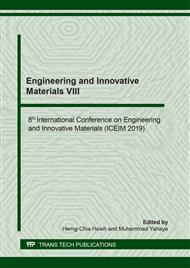p.237
p.243
p.251
p.257
p.262
p.267
p.274
p.282
p.289
Upgrading Bagasse Quality by Torrefaction for a Biomass Power Plant
Abstract:
Torrefaction process was employed to upgrade bagasse as a better fuel compared with raw bagasse in a biomass power plant. Torrefaction is a process that unnecessary organic and inorganic matters are removed from the biomass structure. The remaining solid components can then be used as fuel. This preliminary work was a set of experimental investigations of bagasse torrefaction. The process temperatures were varied as 250, 280 and 320 °C during a fixed reaction time of 30 minutes. Moisture content, mass and heating value of untreated bagasse (before) and torrified bagasse (after) were determined and compared for the 3 different temperatures. Then, energy yield for each case was calculated based on the experimental results to find the optimal condition of bagasse torrefaction. At 320 °C, moisture content was reduced by 92.4% and the torrified bagasse has 4 times higher heating value compared to raw bagasse. While at 250 °C, the reduction of moisture was only 79.7% with approximately 2 times higher in heating value. It was found that the higher reaction temperature was, the better physical structure and higher heating value were. However, higher temperature resulted in lower remaining mass and less energy yield. Therefore, the optimum case was selected based on the energy yield. It was shown that the highest energy yield of 176% was obtained in the case of 250 °C. On the other hand, for the case of 320 °C, energy yield was only 135%. It was thus evident that bagasse should be upgraded by torrefaction process with a temperature as low as 250 °C for a better energy yield rather than better heating value.
Info:
Periodical:
Pages:
267-273
Citation:
Online since:
June 2020
Keywords:
Price:
Сopyright:
© 2020 Trans Tech Publications Ltd. All Rights Reserved
Share:
Citation:



